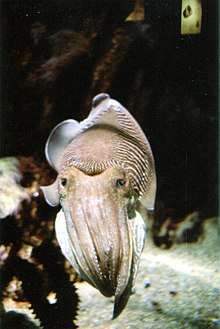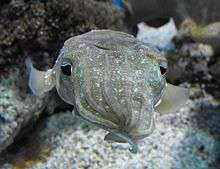Sepia (genus)
Sepia is a genus of cuttlefish in the family Sepiidae encompassing some of the best known and most common species. The cuttlebone is relatively ellipsoid in shape. The name of the genus is the Latinized form of the Ancient Greek σηπία, sēpía, cuttlefish.
| Sepia | |
|---|---|
 | |
| Scientific classification | |
| Kingdom: | Animalia |
| Phylum: | Mollusca |
| Class: | Cephalopoda |
| Order: | Sepiida |
| Family: | Sepiidae |
| Genus: | Sepia Linnaeus, 1758 |
| Subgenera | |
|
Acanthosepion Rochebrune, 1884 | |


Classification
- Genus Sepia
- Subgenus undetermined
- ? Sepia bartletti
- ? Sepia baxteri *
- ? Sepia dannevigi *
- ? Sepia elliptica, ovalbone cuttlefish
- Sepia filibrachia
- Sepia mira
- Sepia plana
- Sepia senta
- Sepia subplana
- ? Sepia whitleyana, Whitley's cuttlefish
- Subgenus Acanthosepion
- Sepia aculeata, needle cuttlefish
- Sepia brevimana, shortclub cutttlefish
- Sepia esculenta, golden cuttlefish
- Sepia lycidas, kisslip cuttlefish
- Sepia prashadi, hooded cuttlefish
- Sepia orbignyana, pink cuttlefish
- Sepia recurvirostra, curvespine cuttlefish
- Sepia savignyi, broadback cuttlefish
- Sepia smithi, Smith's cuttlefish
- Sepia stellifera
- Sepia thurstoni
- Sepia vecchioni[3]
- Sepia zanzibarica
- Subgenus Anomalosepia
- Sepia australis, southern cuttlefish
- Sepia omani, Oman cuttlefish
- Sepia sulcata, grooved cuttlefish
- Subgenus Doratosepion
- Sepia adami
- Sepia andreana, Andrea cuttlefish
- Sepia appellofi
- Sepia arabica, Arabian cuttlefish
- Sepia aureomaculata
- Sepia bathyalis
- Sepia bidhaia
- Sepia braggi, slender cuttlefish
- Sepia burnupi
- Sepia carinata
- Sepia confusa
- Sepia cottoni
- Sepia elongata
- Sepia erostrata
- Sepia foliopeza
- Sepia incerta
- Sepia ivanovi
- Sepia joubini
- Sepia kiensis *
- Sepia kobiensis, Kobi cuttlefish
- Sepia koilados
- Sepia limata
- Sepia longipes, longarm cuttlefish
- Sepia lorigera, spider cuttlefish
- Sepia mascarensis
- Sepia mirabilis
- Sepia murrayi, frog cuttlefish
- Sepia pardex
- Sepia peterseni
- Sepia rhoda
- Sepia saya
- Sepia sewelli
- Sepia sokotriensis
- Sepia subtenuipes
- Sepia tala
- Sepia tanybracheia
- Sepia tenuipes
- Sepia tokioensis
- Sepia trygonina, trident cuttlefish
- Sepia vercoi
- Sepia vietnamica
- Subgenus Hemisepius
- Subgenus Rhombosepion
- Sepia acuminata
- Sepia cultrata, knifebone cuttlefish
- Sepia elegans, elegant cuttlefish
- Sepia hedleyi, Hedley's cuttlefish
- Sepia hieronis
- Sepia madokai, Madokai's cuttlefish
- ? Sepia opipara
- Sepia reesi
- Sepia rex
- Sepia vossi
- Subgenus Sepia
- Sepia angulata *
- Sepia apama, Australian giant cuttlefish
- Sepia bandensis, stumpy-spined cuttlefish
- Sepia bertheloti, African cuttlefish
- Sepia chirotrema
- Sepia dollfusi
- Sepia elobyana, Guinean cuttlefish
- Sepia gibba
- Sepia hierredda, giant African cuttlefish
- Sepia insignis
- Sepia irvingi
- Sepia latimanus, broadclub cuttlefish
- Sepia mestus, reaper cuttlefish
- Sepia novaehollandiae, New Holland cuttlefish
- Sepia officinalis, common cuttlefish
- Sepia papillata
- Sepia papuensis, Papuan cuttlefish
- Sepia pharaonis, pharaoh cuttlefish
- Sepia plangon, mourning cuttlefish
- Sepia plathyconchalis
- Sepia ramani
- Sepia rozella, rosecone cuttlefish
- Sepia simoniana
- Sepia tuberculata
- Sepia vermiculata
- Subgenus undetermined
The species listed above with an asterisk (*) are questionable and need further study to determine if they are a valid species or a synonym. The question mark (?) indicates questionable placement within the genus.
Extinct species
A number of extinct species have been described from the Neogene of Europe, though many of these are likely synonyms.[4] They include:[4]
- Sepia bertii Foresti, 1890
- Sepia complanata Bellardi, 1872
- Sepia craversii Gastaldi, 1868
- Sepia gastaldii Bellardi, 1872
- Sepia granosa Bellardi, 1872
- Sepia harmati Szörenyi, 1933
- Sepia hungarica Lörenthey, 1898
- Sepia isseli Bellardi, 1872
- Sepia michelotti Gastaldi, 1868
- Sepia rugulosa Bellardi, 1872
- Sepia stricta Bellardi, 1872
- Sepia verrucosa Bellardi, 1872
- Sepia vindobonensis Schloenbach, 1869
References
- Whiteaves, J.F. 1897. On some remains of a Sepia-like cuttle-fish from the Cretaceous rocks of the South Saskatchewan. The Canadian Record of Science 7: 459–462.
- Hewitt, R.; Pedley, H. M. (1978). "The preservation of the shells of Sepia in the middle Miocene of Malta". Proceedings of the Geologists' Association. 89 (3): 227–237. doi:10.1016/S0016-7878(78)80013-3.
- Neethiselvan, N. & V.K. Venkataramani 2010. "A New Species of Cuttlefish, Sepia vecchioni (Cephalopoda, Sepiidae) from Colachal Coast, South India". Journal of American Science 6(4): 12–21.
- (in German) Hiden, H.R. 1995. "Sepia vindobonensis (Cephalopoda, Coleoida) aus dem Mittel-Miozän von Retznei (Steiermark, Österreich)" (PDF). Archived from the original (PDF) on 2012-12-22. Retrieved 2012-11-15. Mitteilungen der Abteilung für Geologie und Paläontologie am Landesmuseum Joanneum 52/53: 111–124.


.jpg)
